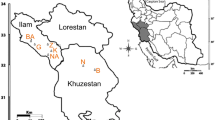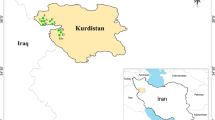Abstract
The present study evaluated the population structure and genetic diversity using inter simple sequence repeat (ISSR) markers in 18 natural populations belonging to three species of Eplingiella (E. cuniloides, E. fruticosa and E. brightoniae), found growing naturally in the semiarid region of Northeast Brazil. Samples of 265 plants were analyzed using nine primer combinations, which generated 131 informative bands. Eplingiella spp. populations showed moderate genetic diversity (percentage of polymorphic bands, PPB = 75.6–96.9%, Nei's genetic diversity He = 0.31–0.39, Shannon's information index I = 0.33–0.48). Molecular variance analysis revealed that within populations, variations contributed more (74%) to the genetic diversity than between population variations (26%), with percentage of the genetic differentiation coefficient (GST = 0.29). The mean value of FST was 0.175, demonstrating good differentiation between populations. The analysis of the structure by the Bayesian method revealed the formation of two groups (K = 2), with many migrant individuals and a high level of miscegenation. The hierarchical cluster dendrogram grouped the 18 populations into two major clusters, with good support for the main clades (100%). According to principal component analysis, the two main principal components explained 21.06% of the total variation. The ISSR markers used were effective in identifying the variability of natural populations of Eplingiella spp., and population structure demonstrated recent diversification of species. The results shed more light on the genetic variation and evolutionary dynamics of Eplingiella, helping to formulate effective breeding strategies.





Similar content being viewed by others
Abbreviations
- ISSR:
-
Inter simple sequence repeat
- PPB:
-
Percentage of polymorphic bands
- He:
-
Nei's genetic diversity
- I:
-
Shannon's information index
- NPb:
-
Number of polymorphic bands
- G ST :
-
Genetic differentiation coefficient
- F ST :
-
Wright’s genetic differentiation coefficient between populations
- PCA:
-
Principal component analysis
References
Andrade AM, Oliveira JPR, Santos ALLM, Franco CRP, Antoniolli AR, Estevam CS, Thomazzi SM (2010) Preliminary study on the anti-inflammatory and antioxidant activities of the leave extract of Hyptis fruticosa Salzm. ex Benth. Lamiaceae Braz J Pharmacog 20:962–968
Archibald JK, Crawford DJ, Santos-Guerra A, Mort ME (2006a) The utility of automated analysis of intersimple sequence repeat (ISSR) loci for resolving relationships in the Canary Island species of Tolpis (Asteraceae). Am J Bot 93:1154–1162
Archibald JK, Mort ME, Crawford DJ, Santos-Guerra A (2006b) Evolutionary relationships within recently radiated taxa: comments on methodology and analysis of inter-simple sequence repeat data and other hypervariable, dominant markers. Taxon 55:747–756
Assaf M, Korkmaz A, Karaman S, Kulak M (2022) Effect of plant growth regulators and salt stress on secondary metabolite composition in Lamiaceae species. S Afr J Bot 144:480–493
Beserra-Filho JIA, Macêdo AM, Leão AHFF, Bispo JMM, Santos JR, Oliveira-Melo AJ, Menezes PP, Duarte MC, Araújo AAS, Silva RH, Quintans-Júnior LJ, Ribeiro AM (2019) Eplingiella fruticosa leaf essential oil complexed with β-cyclodextrin produces a superior neuroprotective and behavioral profile in a mice model of Parkinson’s disease. Food ChemToxicol 124:17–29
Bridi H, Meirelles GC, von Poser GL (2021) Subtribe hyptidinae (Lamiaceae): a promising source of bioactive metabolites. J Ethnopharmacol 264:1–30
Brody JR, Kern SE (2004) Sodium boric acid: atris-free, cooler conductive medium for DNA electrophoresis. Biotechniques 36:2–4
Culley TM, Wellen SG, Sakai AK (2002) The evolution of wind pollination in angiosperms. Trends Ecol Evol 17:361–369
Doyle JJ, Doyle JL (1987) A rapid DNA isolation procedure for small quantities of fresh leaf tissue. Phytochem Bull 19:11–15
Duan B, Li W, Yu Y, Guan Y, Mu S, Li Z, Li X, Kang X (2022) Microsatellite analysis of genetic diversity in wild and cultivated Portunus trituberculatus in Bohai Bay. Mol Biol Rep 49:2543–2551
Evanno G, Regnaut S, Goudet J (2005) Detecting the number of clusters of individuals using the software structure: a simulation study. Mol Ecol 14:2611–2620
Feijó EVRS, Barbosa BL, van den Berg C, Oliveira LM (2022) Genetic diversity of Lippia origanoides Kunth. in natural populations using ISSR markers. Ciênc Agrotec 46:1–8
Felsenstein J (1989) PHYLIP phylogeny inference package (Version 3.2). Cladistics 5:164–166
Flihi J, Rhimi A, Yangui I, Flihi J, Messaoud C, Ali IBE (2022) Genetic diversity and population structure of Tunisian wild Kermes oak (Quercus coccifera L.): assessment by ISSR molecular markers and implication for conservation. Mol Biol Rep 49:6215–6224
Fusani P, Ronga D, Carminati D, Mandrioli M, Manicardi GC, Giannì S, Tava A (2022) Composition and biological activity of essential oils from Artemisia roxburghiana Besser and Elsholtzia fruticosa Rehder cultivated in Italy. Ind Crop Prod 187:1–9
Ghanbari MA, Salehi H, Moghadam A (2022) Genetic diversity assessment of Iranian kentucky bluegrass accessions: I. ISSR markers and their association with habitat suitability within and between different ecoregions. Mol Biotechnol 64:1244–1258
Gupta P, Mishra A, Lal RK, Dhawan SS (2021) DNA fingerprinting and genetic relationships similarities among the accessions/species of Ocimum using SCoT and ISSR markers system. Mol Biol 63:446–457
Harley RM (2014) Eplingiella brightoniae, a new species of hyptidinae (Lamiaceae: Ocimeae) from Northerbn Bahia. Brazil Kew Bulletin 69:1–5
Harley RM, Pastore JFB (2012) A generic revision and new combinations in the Hyptidinae (Lamiaceae), based on molecular and morphological evidence. Phytotaxa 58:1–55
Hartl DL, Jones EW (2005). DNA structure and DNA manipulation. – In: Genetics: analysis of genes and genomes. 5th edn, Sudbury:Jones and Bartlett pub. pp 36– 85
Hashemifar Z, Rahimmalek M (2018) Genetic structure and variation in Perovskia abrotanoides Karel and P. atriplicifolia as revealed by molecular and morphological markers. Sci Hortic 230:169–177
Huelsenbeck JP, Andolfatto P (2007) Inference of population structure under a Dirichlet process model. Genetics 175:1787–1802
Huelsenbeck JP, Andolfatto P, Huelsenbeck ET (2011) Structurama: bayesian inference of population structure. Evol Bioinform Online 7:55–59
Jedrzejczyk I, Rewers M (2018) Genome size and ISSR markers for Mentha L. (Lamiaceae) genetic diversity assessment and species identification. Ind Crops Prod 120:171–179
Kameli M, Hesamzadeh Hejazi SM, Ebadi M (2013) Assessment of genetic diversity on populations of three Satureja species in Iran using ISSR markers. Ann Biol Res 4:64–72
Koohdar F, Sheidai M (2022) Genetic diversity and population structure in medicinal plant Melissa officinalis L. (Lamiaceae). Genet Resour Crop Evol 69:1753–1758
Lima ACB, Paixão MS, Melo M, Santana MT, Damascena NP, Dias AS, Porto YCBS, Fernandes XA, Santos CCS, Lima CA, Quintans Junior LJ, Estevam CS, Araujo BS (2013) Orofacial antinociceptive effect and antioxidant properties of the hydroethanol extract of Hyptis fruticosa Salmz ex Benth. J Ethnopharmacol 146:192–197
Maia MCC (2010) Sistema reprodutivo de populações alogamas e autógamas: modelo básico e equilíbrio. Rev Agro@mbiental Online 4:53–54
Melo AJO, Heimarth L, Carvalho AMS, Quintans JSS, Serafini MRS, Araújo AAS, Alves PB, Ribeiro AM, Saravanan S, Quintans-Júnior LJ, Duarte MC (2020) Eplingiella fruticosa (Lamiaceae) essential oil complexed with β-cyclodextrin improves its anti-hyperalgesic effect in a chronic widespread non-inflammatory muscle pain animal model. Food Chem Toxicol 135:3–9
Moreira IJA, Moreno MON, Fernandes MFG, Fernandes JB, Moreira FV, Antoniolli AR, Santos MRV (2010) Vasorelaxant effect of Hyptis fruticosa Salzm. Ex Benth. Lamiaceae, dichloromethane extract on rat mesenteric artery. Braz J Pharmacog 20:762–766
Munda S, Saikia RJ, Begum T, Bhandari S, Gogoi A, Sarma N, Tamang R, Lal M (2022) Evaluation of genetic diversity based on microsatellites and phytochemical markers of core collection of Cymbopogon winterianus Jowitt. germplasm. Plants 11:1–20
Nei M (1973) Analysis of genetic diversity in subdivided populations (population structure/genetic variability/hetrozygosity/gene differentiation). Proc Natl Acad Sci 70:3321–3323
Nei M (1978) Estimation of average heterozygosity and genetic distance from a small number of individuals. Genetics 89:3583–3590
Nybom H (2004) Comparison of different nuclear DNA markers for estimating intraspecific genetic diversity in plants. Mol Ecol 13:1143–1155
Peakall R, Smouse PE (2012) GenAlEx 6.5: genetic analysis in excel. Population genetic software for teaching and research-an update. Bioinformatics 28:2537–2539
Pearse DE, Crandall KA (2004) Beyond F-ST: Analysis of population genetic data for conservation. Conserv Genet 5:585–602
Peng Y, Nafee-Ul A, Liu M, He Q, Liang Z (2023) Assessment of genetic diversity in bupleurum spp. basing agronomic traits, medicinal components and ISSR markers. Genes 14:1–14
Pinto JAO, Oliveira AKS, Santos EWP, Silva AO, Blank AF, Corrêa CB, Nogueira PCL, Arrigoni MF (2021) Essential oils of Eplingiella fruticosa populations: chemical, antioxidant, and cytotoxic analyses. Res Soc Dev 10:e341101623723
Pritchard J, Stephens M, Donnelly P (2000) Inference of population structure using multilocus genotype data. Genetics 155:945–959
Pritchard J, Wen X, Falush D (2010). Documentation for structure software. [Documentation file] Available with the program at https://www.pritchbsduchicagoedu/structurehtml
Rodrigues L, van den Berg C, Povoa O, Momteiro A (2013) Low genetic diversity and significant structuring in the endangered Mentha cervina populations and its implications for conservation. Biochem Syst Ecol 50:51–61
Saidi M, Movahedi K, Mehrabi AA (2013) Characterization of genetic diversity in Satureja bachtiarica germplasm in Ilamproviance (Iran) using ISSR and RAPD markers. Int J Agric Sci 5:1934–1940
Samarakoon T, Wang SY, Alford MH (2013) Enhancing PCR amplification of DNA from recalcitrant plant specimens using a trehalose-based additive. Appl Plant Sci 1:1–3
Silva DC, Diniz LEC, Blank AF, Nizio DAC, Pinto JAO, Pereira KLG, Arrigoni-Blank MF (2017) Assessment of genetic diversity of a native population of Eplingiella fruticosa: a plant with therapeutic potential. Genet Mol Res 16:1–10
Silva DC, Arrigoni-Blank MF, Bacci L, Blank AF, Faro RRN, Pinto JAO, Pereira KLG (2019) Toxicity and behavioral alterations of essential oils of Eplingiella fruticosa genotypes and their major compounds to Acromyrmex balzani. Crop Prot 116:181–187
Takahata N, Nei M (1984) Fst and Gst statistics in the finite island model. Genetics 107:501–504
Talebi SM, Tabaripour R, Matsyura A (2022) Genetic diversity and population structure of diverse Iranian Nepeta L. taxa. Genet Resour Crop Evol 69:285–296
Triguero-Piñero P, Vega C, Aparicio A, Albaladejo RG (2021) Isolation of microsatellite markers for the endemic Phlomislychnitis (Lamiaceae). Mol Biol Rep 48:8233–8238
Vekemans X, Beauwens T, Lemaire M, Roldán-Ruiz I (2002) Data from amplified fragment length polymorphism (AFLP) markers show indication of size homoplasy and of a relationship between degree of homoplasy and fragment size. Mol Ecol 11:139–151
Wright S (1978) Evolution and the genetics of populations, vol IV. University of Chicago Press, Chicago, Variability within and among natural populations
Yang L, Hisorievd H, Kurbonovad P, Boboeve M, Bobokalonovd K, Feng Y, Lia W (2021) High genetic diversity and low differentiation of endangered Ferula tadshikorum Pimenov in Tajikistan. Glob Ecol Conserv 28:1–8
Yeh FC, Yang R, Boyle T (1999). POPGENE 1.32: Population genetic analysis. Programa para computador livre distribuído pelos autores. 1999. Disponível em: <ftp://ftp.microsoft.com/Softlib/MSLFILES/HPGL.EXE>. Acessado em: 20/01/2022
Zigene ZD, Asfaw BT, Bitima TD (2020) Analysis of genetic diversity in rosemary (Salvia rosemarinus Schleid.) using SSR molecular marker for its management and sustainable use in Ethiopian genebank. Genet Resour Crop Evol 68:279–329
Acknowledgements
The authors thank the Coordenação de Aperfeiçoamento de Pessoal de Nível Superior (CAPES) for financial support (001) and for the postdoctoral research grant given to the fifth (PNPD/UEFS 15950830814). We also thank the Conselho Nacional de Desenvolvimento Científico e Tecnológico (CNPq) for financial support.
Funding
This research was supported by Grant from Coordenação de Aperfeiçoamento de Pessoal de Nível Superior (PNPD/UEFS 15950830814).
Author information
Authors and Affiliations
Contributions
AS: Conceptualization, Methodology, Investigation, Data curation, Writing-Original draft preparation; LO: Conceptualization, Investigation, Methodology, Resources, Data curation, Writing—original draft, Writing—review & editing, Supervision, Funding acquisition; JFBP: Conceptualization, Formal analysis, Data curation, Writing—original draft, Supervision; CvdB: Conceptualization, Resources, Methodology, Data curation, Formal analysis, Writing—original draft, Supervision; TS: Conceptualization, Visualization, Formal analysis, Writing—review & editing; ES: Visualization, Writing—review & editing.
Corresponding author
Ethics declarations
Confict of interest
The authors declare that they have no confict of interest.
Additional information
Publisher's Note
Springer Nature remains neutral with regard to jurisdictional claims in published maps and institutional affiliations.
Rights and permissions
Springer Nature or its licensor (e.g. a society or other partner) holds exclusive rights to this article under a publishing agreement with the author(s) or other rightsholder(s); author self-archiving of the accepted manuscript version of this article is solely governed by the terms of such publishing agreement and applicable law.
About this article
Cite this article
Silva, A.d., de Oliveira, L.M., Pastore, J.F.B. et al. Genetic diversity and population structure of Eplingiella species (Lamiaceae) using ISSR markers. Genet Resour Crop Evol 70, 2801–2813 (2023). https://doi.org/10.1007/s10722-023-01607-7
Received:
Accepted:
Published:
Issue Date:
DOI: https://doi.org/10.1007/s10722-023-01607-7




